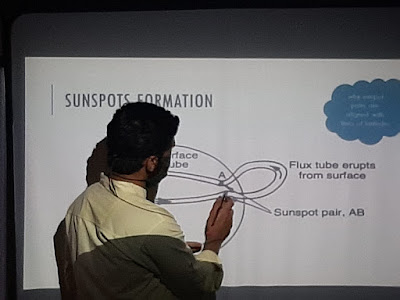Blind
Spot, something we are all familiar with and have experienced it one
time or the other. With all the mirrors around in the car or truck
there will be one area where we cannot see and we have to adapt and
work around it. Sometimes its a matter of life and death. Something
which we cannot observe even with mirrors, this got me thinking of
astronomers and their mirrors, the telescope and blind spot ,that
area where observation is not possible. Earth rotates on its axis
every 24 hours and if a solar eclipse is happening in USA, we in
India will be at the opposite side with nightfall, but at-least
someone got to see the eclipse. But there are places in the sky where
if some events happen nowhere on earth can we see or observe the
event. This is the portion of the sky where the Sun is placed.
On
a new moon day we cannot the see the moon, it's not that moon has
vanished from the sky but its hidden in the glare of the Sun. When a
celestial object is close to the Sun we call that object as, in
conjunction with Sun. During new moon phase the moon is in
conjunction with the Sun. This applies to planets too, planets
Jupiter and Saturn were in conjunction with Sun in late January of
this year and as you know by now, conjunction means close to the Sun.
When planets are in conjunction with the Sun observations cannot
happen and we have to wait for the planets to come out of Sun's
glare. This can take from several days to months and during that time
there is nothing that the earth bound astronomers can do but wait.
The
dreaded wait, how many of you reading this article remember the wait
for the emergence of COMET ISON in 2013. The COMET ISON was dubbed to
be the comet of the century and was to be the brightest comet in the
sky after its perihelion (close approach to Sun). The comet was
observed and followed until it fell into the glare of the Sun,
amateurs and professional astronomers waiting to see the reappearance
never got the chance as the comet got disintegrated during its close
approach to Sun. We had wonderful images before it went close to Sun,
but as it got close to Sun all we could do was to wait for emergence
as sun's glare hid the comet.
If
we go back in time to 1994 and the event of great impact of comet
Shoemaker Levy 9 on to the planet Jupiter, which proved Eugene
Shoemaker's theory of the impacts by comets and asteroids on Planets
are common, well in astronomical timeline of-course. The event took
place in July and telescopes around the world were pointing at
Jupiter and astronomers studied the event in great detail. At that
time Jupiter was in the constellation of Virgo and the Sun was in the
constellation of Gemini. Imagine if the same event would have taken
place during conjunction of Jupiter with Sun, we would have missed
the great event.
Its
not only planets but stars and other celestial objects too that come
close to the Sun in the sky during the year, reaching conjunction,
and those objects also cannot be observed until they emerge out of
the glare. For example ,in the month of February Sun is in the
constellation of Capricornus and we cannot see the stars or the
objects in the constellation due to the bright Sun.
In
the month of January of 2020 the red star in Orion constellation,
Betelgeuse, dimmed in brightness unexpectedly and astronomers were
able to measure the brightness until it came back to its original
brightness in April of 2020. This was a good opportunity to study
the brightness variation of the star as Betelgeuse was well placed in
the sky away from the bright Sun. The same event if it had happened
in the month of June, you know where I am going with this, yes
Betelgeuse will be in conjunction with Sun in June.
There
are many such rare events that we could have missed if the event had
taken place during conjunction with Sun, even the closest supernova
in Large Magellanic Cloud which took place in 1987 if it had happened
during conjunction.
Sun
is a big blind spot for astronomers, even with their mirrors they
will miss anything close to Sun. Astronomers take advantage of even
the smallest window and try to learn everything they can, because
they know that these are rare events. For astronomers there is no
such thing as being at right time at right place, they have to make
best of what they get.
Knowing
this I am very sure that it will make us look at each event and night
as a gift and accept it with a sense of gratitude.

















